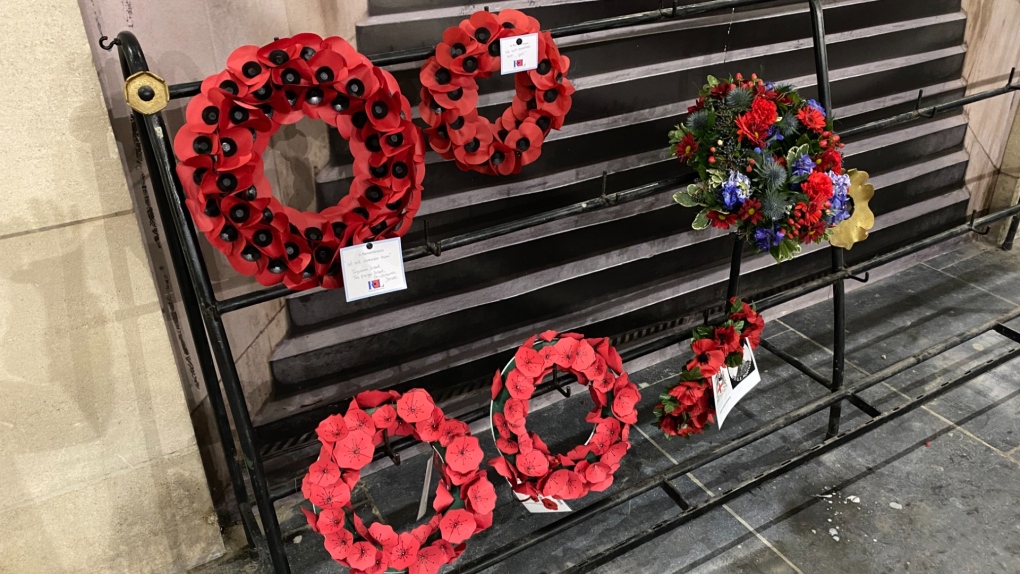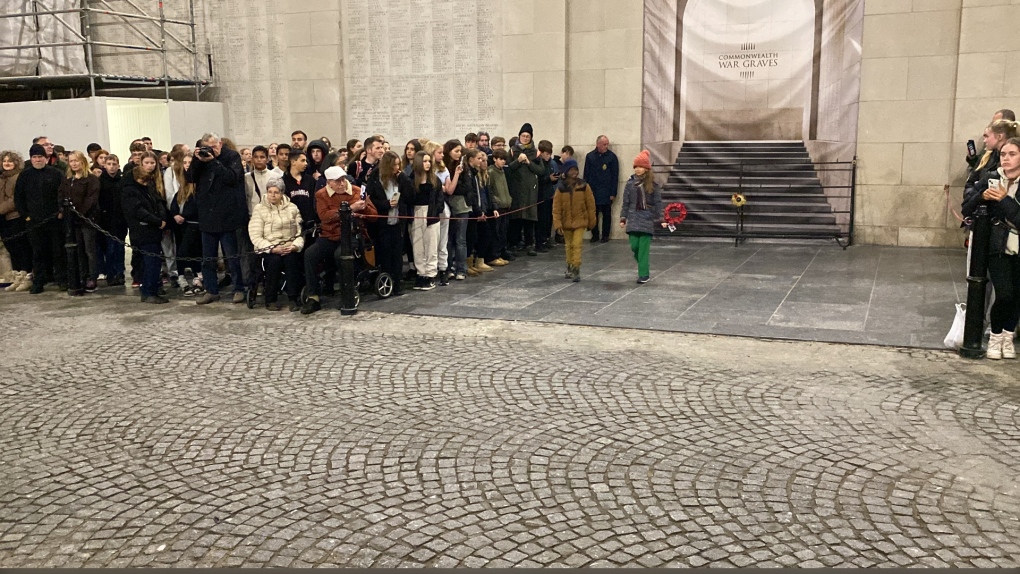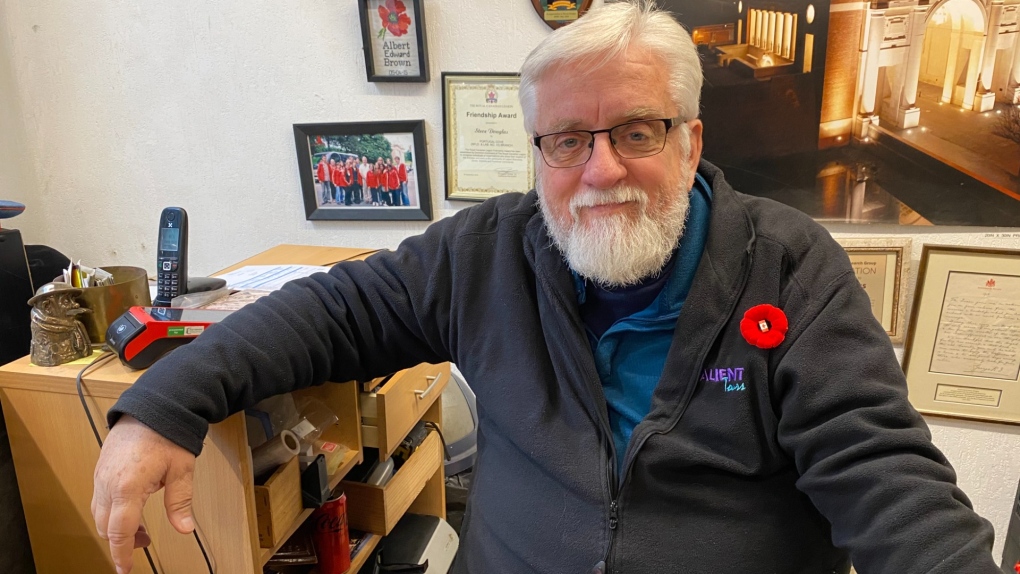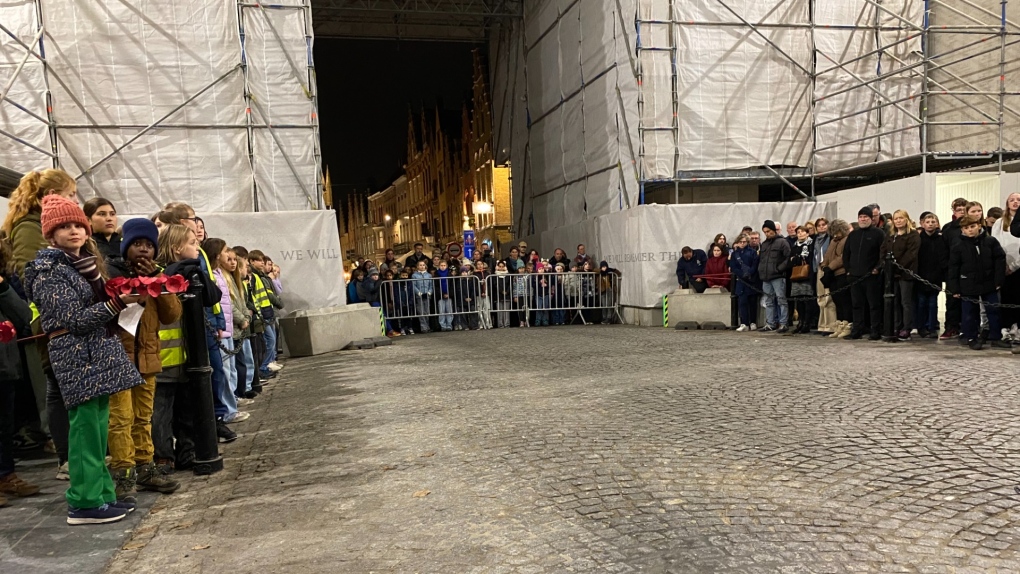Sacred ground: Canadian delegation in Belgium for Remembrance Day ceremonies
Hundreds of school children watched in silence as buglers performed the Last Post at the Menin Gate in historic Ypres, Belgium, Wednesday night.
The moving ceremony takes place every evening at 8 p.m. to honour and remember soldiers who fought and died in Ypres during the First World War.
 Wreaths of poppies are pictured in Ypres, Belgium. (Derek Haggett/CTV Atlantic)
Wreaths of poppies are pictured in Ypres, Belgium. (Derek Haggett/CTV Atlantic)
Children and descendants of veterans place wreaths made of poppies to show their respect and to remember those who died in the Great War over 100 years ago.
Youri Van Miegroet is a ceremonial assistant with the Last Post Association.
Every night, along with his colleagues, the volunteer makes sure the ceremony goes as planned.
“Tonight it was British children, it was Dutch children and it was Belgium children, so it was a great mixture of different countries,” said Van Miegroet.
 Children lay a wreath during the Last Post ceremony held at Menin Gate in Ypres, Belgium, on Nov. 6, 2024. (Derek Haggett/CTV Atlantic)
Children lay a wreath during the Last Post ceremony held at Menin Gate in Ypres, Belgium, on Nov. 6, 2024. (Derek Haggett/CTV Atlantic)
Van Miegroet said Ypres was the last part of Belgium that was never taken over by the German Army.
“They were stopped a little outside Ypres, which we call the salient, and it moved a little bit backwards and forwards, but they were never able to capture our beloved city which was completely destroyed,” he said.
Three major battles took place at Ypres.
According to the Canadian Encyclopedia, the Second Battle of Ypres was fought in the spring of 1915 and was the first major battle for Canada.
Fighting took place against the German Empire on the Western Front near the French border.
Canadian soldiers first established themselves as a force after resisting the first large scale poisonous gas attack in the history of warfare.
Over 6,500 Canadians were killed, wounded or captured during the Second Battle of Ypres.
Canadian Stephen Douglas owns a souvenir shop and Salient Tour business in Ypres.
The Kitchener, Ont., man left Canada in 1997 to start the Maple Leaf Legacy Project.
The idea behind the project was to photograph all the Canadian war graves and put them online for those who couldn’t travel to Europe to see them.
 Stephen Douglas, owner of Salient Tours, is pictured in Ypres, Belgium. (Derek Haggett/CTV Atlantic)
Stephen Douglas, owner of Salient Tours, is pictured in Ypres, Belgium. (Derek Haggett/CTV Atlantic)
Douglas said Ypres was the focal point for the British and Commonwealth forces on the Western Front.
“Almost everybody that served in the British Army, Canadian Army, Australia, New Zealand, almost everybody fought here at some point,” said Douglas.
The area was strategically important to the Germans because it was very close to France’s coastal ports and a gateway to Paris, said Douglas.
“This was the place where the British held the line,” said Douglas. “The Canadians were a big part of this. The Second Battle of Ypres, the gas attack, they were in the thick of it all.”
Canadians also participated in the Third Battle of Ypres, also known as the Battle of Passchendaele, in 1917.
“Very significant. Very much a major force to be reckoned with for the Germans in this area,” said Douglas. “The Canadians were here for a long period.”
Douglas said the Belgium people still very much appreciate the sacrifices made my Allied soldiers in the Great War, which took place from 1914 to 1918.
CTV News is part of a Canadian delegation commemorating fallen Indigenous Canadian service members from the First World War.
The delegation is made up First Nations chiefs, elders, veterans, community members and descendants of veterans from across the country.
The group will attend a series of ceremonies and events throughout Belgium right up until Remembrance Day.
It’s a very special trip for honorary captain and Mi’kmaw Native Friendship Centre elder Debbie Eisan.
A veteran herself, Eisan spent 36 years in the Royal Canadian Navy.
“I’m so honoured to be doing this,” said Eisan. “To me, it’s important to remember the veterans that have gone before us. When you step over here it’s much different. It’s so serene and it’s so beautiful the way that they honour our veterans here and it’s talked about every day. Very similar to the Indigenous people. We honour our veterans every single day of the year.”
Eisan said Canada’s Indigenous population were not required to enlist to fight overseas, but many did anyway because they felt it was the right thing to do.
“They did this because it was our responsibility on our side of the treaties to fight for Turtle Island. So when Canada went to war during World War I, thousands of Indigenous men and women travelled thousands of kilometres to sign up to fight for Turtle Island,” said Eisan. “They wanted to make Turtle Island, North America, a better place for their families.”
Two descendants of two highly decorated Canadian Armed Forces Indigenous service members are also part of the delegation and ceremonies are planned this week for their ancestors.
 A group of people attend the daily Last Post ceremony held at Menin Gate in Ypres, Belgium, on Nov. 6, 2024. (Derek Haggett/CTV Atlantic)
A group of people attend the daily Last Post ceremony held at Menin Gate in Ypres, Belgium, on Nov. 6, 2024. (Derek Haggett/CTV Atlantic)
On Friday, the delegation will participate in the Last Post ceremony at the Menin Gate for Indigenous Veterans Day, which recognizes the proud tradition of Canadian military service of First Nations People.
The delegation will also be on hand for Remembrance Day ceremonies in Ypres on Monday.
Click here for more photos from around Ypres.
This article was produced in partnership with Visit Flanders.
CTVNews.ca Top Stories

Trump threatens to try to take back the Panama Canal. Panama's president balks at the suggestion
Donald Trump suggested Sunday that his new administration could try to regain control of the Panama Canal that the United States “foolishly” ceded to its Central American ally, contending that shippers are charged “ridiculous” fees to pass through the vital transportation channel linking the Atlantic and Pacific Oceans.
Man handed 5th distracted driving charge for using cell phone on Hwy. 417 in Ottawa
An Ottawa driver was charged for using a cell phone behind the wheel on Sunday, the fifth time he has faced distracted driving charges.
Wrongfully convicted N.B. man has mixed feelings since exoneration
Robert Mailman, 76, was exonerated on Jan. 4 of a 1983 murder for which he and his friend Walter Gillespie served lengthy prison terms.
Can the Governor General do what Pierre Poilievre is asking? This expert says no
A historically difficult week for Prime Minister Justin Trudeau and his Liberal government ended with a renewed push from Conservative Leader Pierre Poilievre to topple this government – this time in the form a letter to the Governor General.
opinion Christmas movies for people who don't like Christmas movies
The holidays can bring up a whole gamut of emotions, not just love and goodwill. So CTV film critic Richard Crouse offers up a list of Christmas movies for people who might not enjoy traditional Christmas movies.
More than 7,000 Jeep SUVs recalled in Canada over camera display concern
A software issue potentially affecting the rearview camera display in select Jeep Wagoneer and Grand Cherokee models has prompted a recall of more than 7,000 vehicles.
'I'm still thinking pinch me': lost puppy reunited with family after five years
After almost five years of searching and never giving up hope, the Tuffin family received the best Christmas gift they could have hoped for: being reunited with their long-lost puppy.
10 hospitalized after carbon monoxide poisoning in Ottawa's east end
The Ottawa Police Service says ten people were taken to hospital, with one of them in life-threatening condition, after being exposed to carbon monoxide in the neighbourhood of Vanier on Sunday morning.
New York City police apprehend suspect in the death of a woman found on fire in a subway car
New York City police announced Sunday they have in custody a “person of interest” in the early morning death of a woman who they believe may have fallen asleep on a stationary subway train before being intentionally lit on fire by a man she didn't know.


































